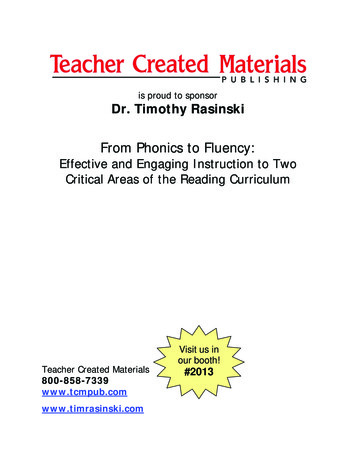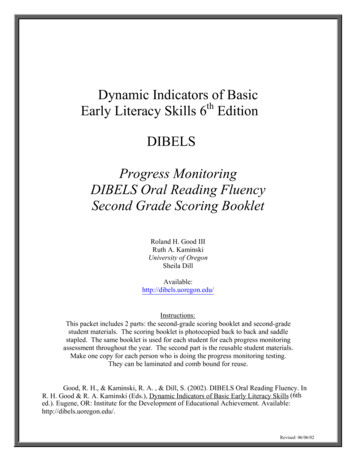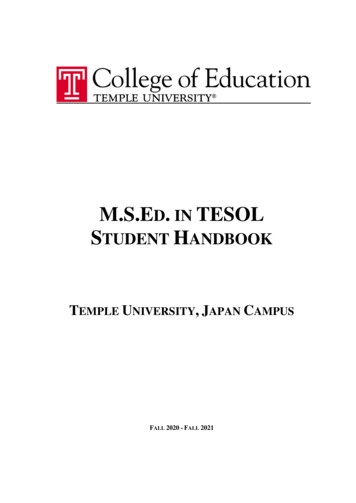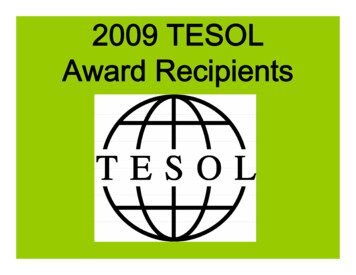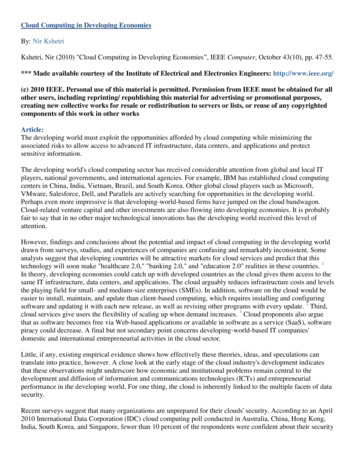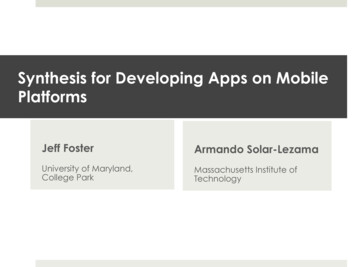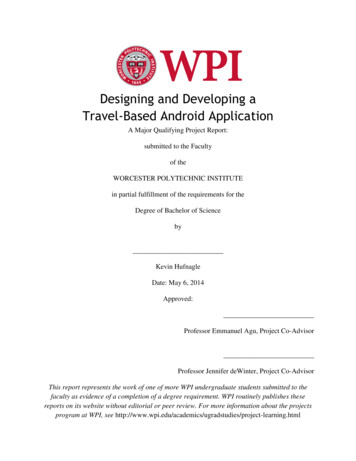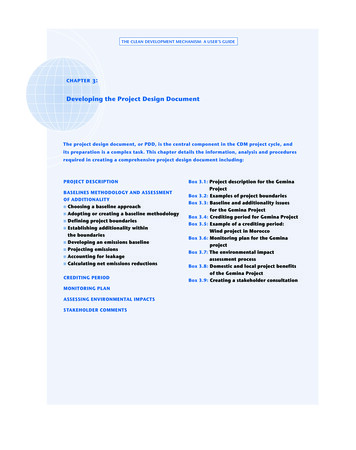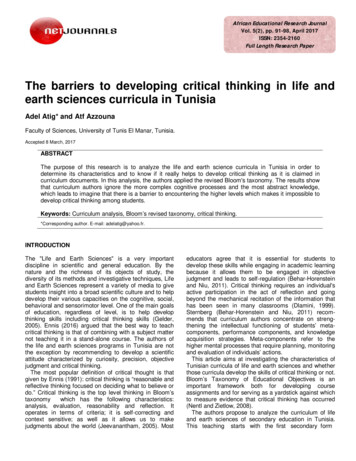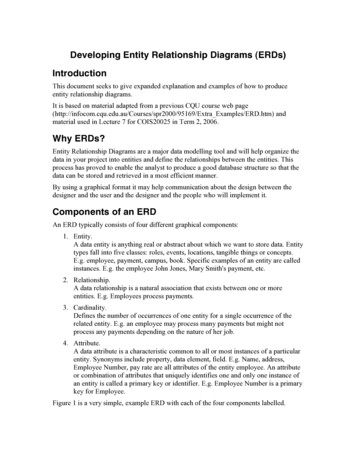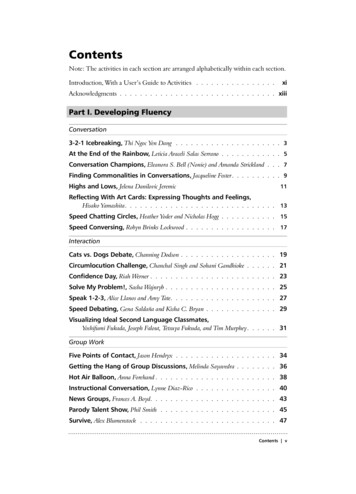
Transcription
ContentsNote: The activities in each section are arranged alphabetically within each section.Introduction, With a User’s Guide to Activities. . . . . . . . . . . . . . . . .xiAcknowledgments. . . . . . . . . . . . . . . . . . . . . . . . . . . . . . . . xiiiPart I. Developing FluencyConversation3-2-1 Icebreaking, Thi Ngoc Yen Dang. . . . . . . . . . . . . . . . . . . . . . 3At the End of the Rainbow, Leticia Araceli Salas Serrano. . . . . . . . . . . . . 5Conversation Champions, Eleanora S. Bell (Nonie) and Amanda Strickland. . . . 7Finding Commonalities in Conversations, Jacqueline Foster. . . . . . . . . . 9Highs and Lows, Jelena Danilovic Jeremic11Reflecting With Art Cards: Expressing Thoughts and Feelings,Hisako Yamashita. . . . . . . . . . . . . . . . . . . . . . . . . . . . . . 13Speed Chatting Circles, Heather Yoder and Nicholas Hogg. . . . . . . . . . . . 15Speed Conversing, Robyn Brinks Lockwood. . . . . . . . . . . . . . . . . . . 17InteractionCats vs. Dogs Debate, Channing Dodson. . . . . . . . . . . . . . . . . . . . 19Circumlocution Challenge, Chanchal Singh and Sohani Gandhioke. . . . . . . 21Confidence Day, Riah Werner. . . . . . . . . . . . . . . . . . . . . . . . . . 23Solve My Problem!, Sasha Wajnryb. . . . . . . . . . . . . . . . . . . . . . . 25Speak 1-2-3, Alice Llanos and Amy Tate. . . . . . . . . . . . . . . . . . . . . 27Speed Debating, Gena Saldaña and Kisha C. Bryan. . . . . . . . . . . . . . . 29Visualizing Ideal Second Language Classmates,Yoshifumi Fukada, Joseph Falout, Tetsuya Fukuda, and Tim Murphey. . . . . . 31Group WorkFive Points of Contact, Jason Hendryx. . . . . . . . . . . . . . . . . . . . . 34Getting the Hang of Group Discussions, Melinda Sayavedra. . . . . . . . . 36Hot Air Balloon, Anna Forehand. . . . . . . . . . . . . . . . . . . . . . . . . 38Instructional Conversation, Lynne Diaz-Rico. . . . . . . . . . . . . . . . . 40News Groups, Frances A. Boyd. . . . . . . . . . . . . . . . . . . . . . . . . 43Parody Talent Show, Phil Smith. . . . . . . . . . . . . . . . . . . . . . . . 45Survive, Alex Blumenstock. . . . . . . . . . . . . . . . . . . . . . . . . . . . 47Contents v
Dialogues and Role-PlaysEnglish or Englishes?, Andy Halvorsen. . . . . . . . . . . . . . . . . . . . . 50Making Requests: Holiday Role-Play, Kimberly Flynn. . . . . . . . . . . . . 53Picture-Inspired Dialogues, Martha Raab. . . . . . . . . . . . . . . . . . . 55Talk Show Role-Play, Katherine Miller. . . . . . . . . . . . . . . . . . . . . . 57What Are You Going to Do?, Janine Berger. . . . . . . . . . . . . . . . . . 59Game-Based LearningBluff, Gordon Blaine West. . . . . . . . . . . . . . . . . . . . . . . . . . . . . 61Countdown Timer Faceoff, Gordon Blaine West. . . . . . . . . . . . . . . . 63Double or Nothing, Shantaya Ijya Rao. . . . . . . . . . . . . . . . . . . . . 65Rubbed Out: Discussion in Mafia Games, Michael Madson. . . . . . . . . . 68Say Something Interesting, Cameron Romney. . . . . . . . . . . . . . . . . 71The Say 3 Challenge, Kevin McCaughey. . . . . . . . . . . . . . . . . . . . 73Un-Taboo: Modified Taboo, Ildiko Porter-Szucs. . . . . . . . . . . . . . . . 75Part II. Developing AccuracyGrammatical Task-Based SpeakingABC Conversation, Magali Arteaga. . . . . . . . . . . . . . . . . . . . . . . 79Conditionals Creation: Expected to Absurd, Elena Shvidko. . . . . . . . . 81Confirming or Denying Truths and Lies With Tag Endings,Cathrine-Mette Mork. . . . . . . . . . . . . . . . . . . . . . . . . . . . . 83Crowdsourced Conversation, Sherry Schafer. . . . . . . . . . . . . . . . . 85Devil’s Advocate: Teaching Students How to Disagree Politely,Sara Okello. . . . . . . . . . . . . . . . . . . . . . . . . . . . . . . . . 87Following Up With Follow-Up Questions, Kurtis McDonald. . . . . . . . . 89Follow the Leader, Patricia Hart. . . . . . . . . . . . . . . . . . . . . . . . 92Let Me Ask: Yes/No Questions, Phoebe Daurio. . . . . . . . . . . . . . . . . 94Tag Question Collection, Jesse Giacomini. . . . . . . . . . . . . . . . . . . . 96VocabularyI Don’t Believe It!, Amy Crofford. . . . . . . . . . . . . . . . . . . . . . . . 98I’m Proud to Be . . . , Melissa Quasunella and Jenna Bollinger. . . . . . . . . .100Name It and Claim It Game, Janet Pierce. . . . . . . . . . . . . . . . . . .103vi NEW WAYS IN TEACHING SPEAKING
Spell, Write, Speak, Smoky Kelly. . . . . . . . . . . . . . . . . . . . . . .105Vocabulary Scattergories, Michele Kim. . . . . . . . . . . . . . . . . . .108Part III. Developing PronunciationSegmental PhonemesFavorite Things: Learning the Pronunciation of the Final –S Sound,Jolene Jaquays and Sara Okello. . . . . . . . . . . . . . . . . . . . . . .113Pronunciation Practice: \v\ and \f\ Sounds,Bernadette M. López-Fitzsimmons and Amanda D’Alto. . . . . . . . . . . .115Vowel Walk, Eileen Boswell. . . . . . . . . . . . . . . . . . . . . . . . . .118Suprasegmental PhonemesFocused Pronunciation Practice for Presentations, DJ Kaiser. . . . . .120Presenting Poetry and Prose, John Schmidt. . . . . . . . . . . . . . . . .122Syllable Stones, Marla Yoshida. . . . . . . . . . . . . . . . . . . . . . . .124The Inner-Outer Circle: A Platform to Integrate PronunciationInto Speaking, Ivanne Deneroff. . . . . . . . . . . . . . . . . . . . . .127Game-Based LearningFishing for Pronunciation, Patricia Hart. . . . . . . . . . . . . . . . . . .130Minimal Pair Memory, Patricia Hart. . . . . . . . . . . . . . . . . . . . .132Pronunciation Basketball, Melinda Cuyul-Gordon. . . . . . . . . . . . . .134MiscellaneousPeer Dictation, Jean L. Arnold. . . . . . . . . . . . . . . . . . . . . . . . .137Pronunciation Workouts With Print or Online Resources,William Haselton. . . . . . . . . . . . . . . . . . . . . . . . . . . . . .139Quote of the Day, Eileen Boswell. . . . . . . . . . . . . . . . . . . . . . .141See It Right, Charles Hall. . . . . . . . . . . . . . . . . . . . . . . . . . .144Part IV. Speaking in Specific ContextsInterviews and QuestioningClass Statistics, Jesse Giacomini. . . . . . . . . . . . . . . . . . . . . . . .149Job Interviews in Pairs: Talk and Evaluate, Feifei Han. . . . . . . . . . .151Job Interviews in Trios, Vander Viana. . . . . . . . . . . . . . . . . . . . .153Contents vii
On Your Feet, John Schmidt. . . . . . . . . . . . . . . . . . . . . . . . . .155Reported Speech With Famous Quotations, Amber Scroggs. . . . . . . .158Who’s Who in My Community, Zuzana Tomaš. . . . . . . . . . . . . . .160Oral Presentation SkillsBinary Feature Assessment for Presentations, DJ Kaiser. . . . . . . . .162Compelling Conclusions to Speeches, Lisa Leopold. . . . . . . . . . . .165Confronting Challenging Sentences: Station Rotationand Panel of Experts, Eileen Boswell. . . . . . . . . . . . . . . . . .167Dynamic Transitions, Raquel M. Rojas. . . . . . . . . . . . . . . . . . . .170Moving Beyond Body Language Basics, Lisa Leopold. . . . . . . . . . .172Oral PresentationsMovie Magic Collages, Katherine Rhodes Fields and Tamara Warhol. . . . . .175Presenting on Public Squares as Symbols of Cultureand Identity, Irene Wan. . . . . . . . . . . . . . . . . . . . . . . . .177Simultaneous Presentations in Pairs, Wendy Sagers. . . . . . . . . . . .180Spoken English for Academic and Professional PurposesA Poster Session, Jean Kirschenmann and Sally La Luzerne-Oi. . . . . . . . .182Discussion and Facilitation: Leading a Presentation, Kia Dennis. . . . .185Discussion and Facilitation: Strengthening Skills in Class Activities,Lisa Leopold. . . . . . . . . . . . . . . . . . . . . . . . . . . . . . . .187Elevator Pitch Competition for Environmental NGOs, Julie Vorholt. . . .189Group Presentation of a Community-Based Business Plan,Stephanie N. Marcotte. . . . . . . . . . . . . . . . . . . . . . . . . . .192Mock Parliament: Discussing Changes in the Law, Elena Amochkina. . .195The Five-Paragraph Debate, Gunther Wiest. . . . . . . . . . . . . . . . .197Understanding the Oral Defense Process: Studentsas Ethnographers, Joseph J. Lee. . . . . . . . . . . . . . . . . . . . .200What’s My Word?, Chris Banister. . . . . . . . . . . . . . . . . . . . . . .202Young SpeakersCartoon Speaking Presentations, Janet Pierce. . . . . . . . . . . . . . . .205Family Survey, Robert J. Meszaros. . . . . . . . . . . . . . . . . . . . . . .207Ordering Food in a High School,Melissa Quasunella and Hannah Massengill. . . . . . . . . . . . . . . . .209viii NEW WAYS IN TEACHING SPEAKING
Structured Sing-Along, Jeff Popko. . . . . . . . . . . . . . . . . . . . . .211The Country That I Want to Go To, Gerry McLellan. . . . . . . . . . . . .213Vocabulary and Pronunciation Slap, Steven G. B. MacWhinnie. . . . . . .215Walkie-Talkie Role-Play, Jennifer Russell. . . . . . . . . . . . . . . . . . . .217Part V. Speaking and TechnologyDeveloping Fluency and Accuracy Using TechnologyAngry Birds and Directions, Tingting Kang. . . . . . . . . . . . . . . . .221Creating Mini–TED Talks to Increase Speaking Fluency,Zuzana Tomaš. . . . . . . . . . . . . . . . . . . . . . . . . . . . . . .223Google Earth Field Trip, Emma Tudor. . . . . . . . . . . . . . . . . . . .225International Video Chats, André Hedlund. . . . . . . . . . . . . . . . .227Lights, Camera, Action in Autos, John Schmidt. . . . . . . . . . . . . . .229Shadowing Fluency, Ranwa Khorsheed. . . . . . . . . . . . . . . . . . . .232Smartphone Speaking, Marcella A. Farina. . . . . . . . . . . . . . . . . .234Star in a Viral Marketing Video, Sean H. Toland. . . . . . . . . . . . . .237Storytelling With Cell Phones, Robert J. Meszaros. . . . . . . . . . . . . .240Student-Generated Podcasts as Speaking Portfolio, Bita Bookman. . .242Super Selfies, Martin Cooke. . . . . . . . . . . . . . . . . . . . . . . . . .245Teaching Small Talk, Bryan Woerner. . . . . . . . . . . . . . . . . . . . . .248Video Recording on Flipgrid, Laura Giacomini. . . . . . . . . . . . . . .251Developing Pronunciation Using TechnologyNumbers Ping Pong With Speech Recognition, Daniel Buller. . . . . . .253Pronunciation With Mobile Apps, Hoa Thi Thanh Bui. . . . . . . . . . .255Sounds Like the Real Mobile Me, Stephen J. Hall. . . . . . . . . . . . . .257Spoken English for Academic and Professional Purposes Using TechnologyImproving Presentation Skills With PechaKucha, Suzan Stamper. . . . .259Online Visuals and Effective Public Speaking, Kendra Wray. . . . . . . .262Postpresentation: Peer Feedback and Self-ReflectionWith Socrative, Valeria Bogorevich and Elnaz Kia. . . . . . . . . . . . .264Using Set Summary Phrases to Reference Outside Sources,Evelyn Pierro. . . . . . . . . . . . . . . . . . . . . . . . . . . . . . . .267Contents ix
INTRODUCTION, WITH AUSER’S GUIDE TO ACTIVITIESWelcome to New Ways in Teaching Speaking Second Edition!The purpose of the New Ways series remains the same as when it began, “. . . topublish ideas written by teachers for teachers.” This is the first line of the introduction from the first edition of New Ways in Teaching Speaking (Teachers of English toSpeakers of Other Languages, 1994, p. viii), which was coedited by Dr. KathleenM. Bailey and Lance Savage. Also remaining the same in this specific volume is thefocus on teaching speaking, an essential skill for many language learners.Both editions contain more than 100 activities, submitted by English language teaching professionals from around the world. They volunteered to share their expertisefrom their perspectives as instructors in English as a second language and Englishas a foreign language contexts and as native and nonnative English speakers themselves. Their submissions constitute a wide array of engaging activities that havesucceeded when taught in their own classrooms. Their contributions represent different approaches and techniques in language teaching in a multitude of situations.Successful instruction can occur in diverse ways (Cook, 2016), and these activitiesillustrate that. For ease of use, the book is organized into major categories. The sections, however, were not planned in advance for either the first edition (Bailey &Savage, 1994) or this one. Instead, the contributions from the teachers were used todetermine the major categories and smaller subsections.More than 100 brand new activities are in this new edition. They are divided intofive major categories: Developing Fluency (Part I), Developing Accuracy (Part II),Developing Pronunciation (Part III), Speaking in Specific Contexts (Part IV), andSpeaking and Technology (Part V).The widespread use of technology in teaching is evident by the addition of theextensive new category Speaking and Technology, in which teachers incorporate avariety of technological tools, such as tablets, internet-connected projectors, andsmartphones. These tools allow students to create podcasts, film movies, recordother video or audio clips, time themselves, and more—all to improve their speakingskills while utilizing their digital literacy skills. This experience supports students’development as “effective and independent learners who can take advantage of thetools and resources for language learning in authentic contexts” (Son, Park, & Park,2017, p. 95). In this new Speaking and Technology category, more than 20 activities are divided into three subsections. The first and largest is Developing Fluencyand Accuracy Using Technology. These activities vary in their aims. Some activities concentrate on improving fluency, some on accuracy, some on both, and somecan be adapted to shift the concentration. The second subsection is DevelopingPronunciation Using Technology and the third is Spoken English for Academic andProfessional Purposes Using Technology.This new edition includes an expanded subsection with career-focused content.Speaking in Specific Contexts contains a subsection titled Spoken English forAcademic and Professional Purposes. The new career-focused activities connect towork in business, law, and more, illustrating the value of additional instruction inINTRODUCTION, WITH A USER’S GUIDE TO A
Movie Magic Collages, Katherine Rhodes Fields and Tamara Warhol. 175 Presenting on Public Squares as Symbols of Culture and Identity, Irene Wan . 177 Simultaneous Presentations in Pairs, Wendy Sagers. 180 Spoken English for Academic and Professional Purposes A Poster Session, Jean Kirschenmann and Sally La Luzerne-Oi. 182 Discussion and Facilitation: Leading a Presentation,
